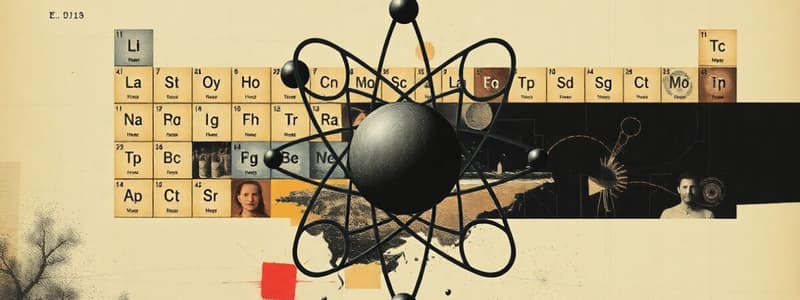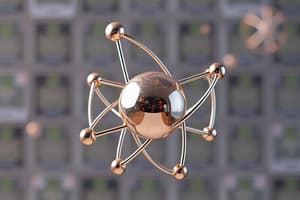Podcast
Questions and Answers
What is the location of a neutron in an atom?
What is the location of a neutron in an atom?
- Nucleus (correct)
- Electron cloud
- Between protons and electrons
- Outer shell
In the periodic table, elements in the same group have the same number of electron shells.
In the periodic table, elements in the same group have the same number of electron shells.
False (B)
Who organized the first periodic table?
Who organized the first periodic table?
Dimitri Mendeleev
The relative charge of a proton is ______.
The relative charge of a proton is ______.
Match the following particles with their characteristics:
Match the following particles with their characteristics:
Which element has the chemical symbol 'O'?
Which element has the chemical symbol 'O'?
Helium can be divided into simpler substances by a chemical process.
Helium can be divided into simpler substances by a chemical process.
What is the smallest particle into which an element can be divided without losing its properties?
What is the smallest particle into which an element can be divided without losing its properties?
The chemical symbol for Sodium is ______.
The chemical symbol for Sodium is ______.
Match the following elements with their chemical symbols:
Match the following elements with their chemical symbols:
What unit is used to measure radiation?
What unit is used to measure radiation?
The Atomic Mass (RAM) is defined as the average mass of a molecule compared to the mass of one atom of carbon-12.
The Atomic Mass (RAM) is defined as the average mass of a molecule compared to the mass of one atom of carbon-12.
What is the RAM of chlorine based on its isotopes?
What is the RAM of chlorine based on its isotopes?
RMM stands for ______.
RMM stands for ______.
Match the following terms with their definitions:
Match the following terms with their definitions:
What type of bonding occurs only between metals?
What type of bonding occurs only between metals?
Covalent bonding can occur between metals.
Covalent bonding can occur between metals.
What type of bonding is characterized by the transfer of electrons?
What type of bonding is characterized by the transfer of electrons?
A _____ bond occurs between nonmetals to form a molecule.
A _____ bond occurs between nonmetals to form a molecule.
Match the type of bonding with its description:
Match the type of bonding with its description:
What type of bond occurs between metals and nonmetals?
What type of bond occurs between metals and nonmetals?
Compounds are formed only from atoms of the same type.
Compounds are formed only from atoms of the same type.
What is the charge of the cations formed from metals during ionic bonding?
What is the charge of the cations formed from metals during ionic bonding?
In ionic bonding, nonmetals gain __________ to form anions.
In ionic bonding, nonmetals gain __________ to form anions.
According to the law of triads, how are elements organized?
According to the law of triads, how are elements organized?
Protium, deuterium, and tritium are all isotopes of the same element.
Protium, deuterium, and tritium are all isotopes of the same element.
What is a radioactive isotope used to treat thyroid problems?
What is a radioactive isotope used to treat thyroid problems?
Radioactivity is the spontaneous disintegration of larger unstable atomic nuclei due to the emission of ______.
Radioactivity is the spontaneous disintegration of larger unstable atomic nuclei due to the emission of ______.
Match the following radioactive isotopes with their uses:
Match the following radioactive isotopes with their uses:
Flashcards
Proton
Proton
A subatomic particle with a positive charge, located in the atom's nucleus.
Electron
Electron
A subatomic particle with a negative charge, orbiting the nucleus in electron shells.
Atomic Number
Atomic Number
The number of protons in an atom's nucleus.
Mass Number
Mass Number
Signup and view all the flashcards
Periodic Table Group
Periodic Table Group
Signup and view all the flashcards
What is an atom?
What is an atom?
Signup and view all the flashcards
What is an element?
What is an element?
Signup and view all the flashcards
Hydrogen's symbol
Hydrogen's symbol
Signup and view all the flashcards
What is Helium's symbol?
What is Helium's symbol?
Signup and view all the flashcards
What is Lithium's symbol?
What is Lithium's symbol?
Signup and view all the flashcards
What is a mass spectrometer?
What is a mass spectrometer?
Signup and view all the flashcards
What is a seivert?
What is a seivert?
Signup and view all the flashcards
RAM
RAM
Signup and view all the flashcards
RMM
RMM
Signup and view all the flashcards
How is RAM calculated?
How is RAM calculated?
Signup and view all the flashcards
Chemical Bond
Chemical Bond
Signup and view all the flashcards
Metallic Bonding
Metallic Bonding
Signup and view all the flashcards
Ionic Bonding
Ionic Bonding
Signup and view all the flashcards
Covalent Bonding
Covalent Bonding
Signup and view all the flashcards
Metalloid
Metalloid
Signup and view all the flashcards
Cation
Cation
Signup and view all the flashcards
Anion
Anion
Signup and view all the flashcards
What is a compound?
What is a compound?
Signup and view all the flashcards
Dobereiner's Triads
Dobereiner's Triads
Signup and view all the flashcards
Isotopes
Isotopes
Signup and view all the flashcards
Radioactive Isotope
Radioactive Isotope
Signup and view all the flashcards
What are the 3 types of radiation?
What are the 3 types of radiation?
Signup and view all the flashcards
Uses of Radioactive Isotopes
Uses of Radioactive Isotopes
Signup and view all the flashcards
Study Notes
Atomic Structure
- Atoms - The smallest particle into which an element can be divided without losing any of the properties of that element
- Element - A pure substance that cannot be divided into any simpler substances by any chemical process
Subatomic Particles
-
Proton - +1 charge, relative mass of 1
-
Electron - -1 charge, relative mass of 0
-
Neutron - 0 charge, relative mass of 1
-
Number of electrons = atomic number
-
Number of neutrons = mass number - atomic number
Groups and Periods
-
Group - A vertical column that contains elements with the same number of electrons in the valence or outermost shell
-
Period - A horizontal row that contains elements with the same number of electron shells
-
Group 1 - Alkali Metals
-
Group 2 - Alkali Earth Metals
-
Group 7 - Halogens
-
Group 8 - Noble Gases (inert gases)
Historical Development of Periodic Table
- Developed by Dmitri Mendeleev
- Organized the elements
- Identified patterns
- Predicted properties
- Classified and arranged
- Withstood the test of time
- Listed elements in order of increasing atomic mass
Studying That Suits You
Use AI to generate personalized quizzes and flashcards to suit your learning preferences.




